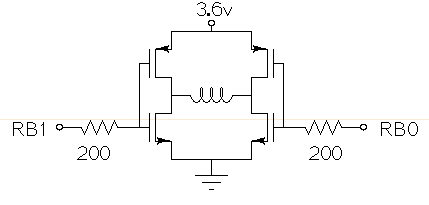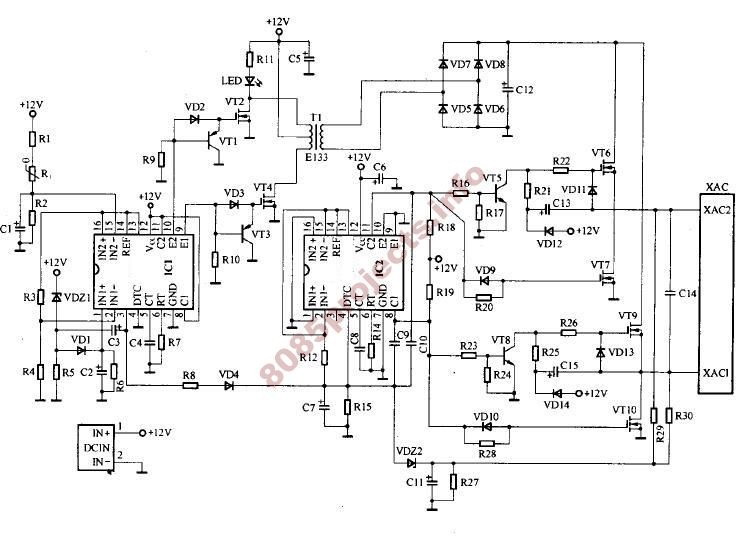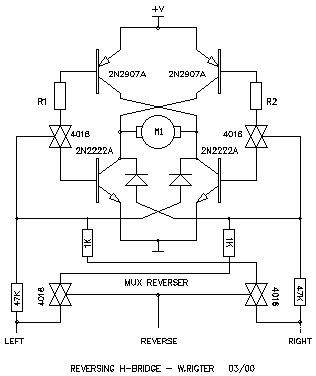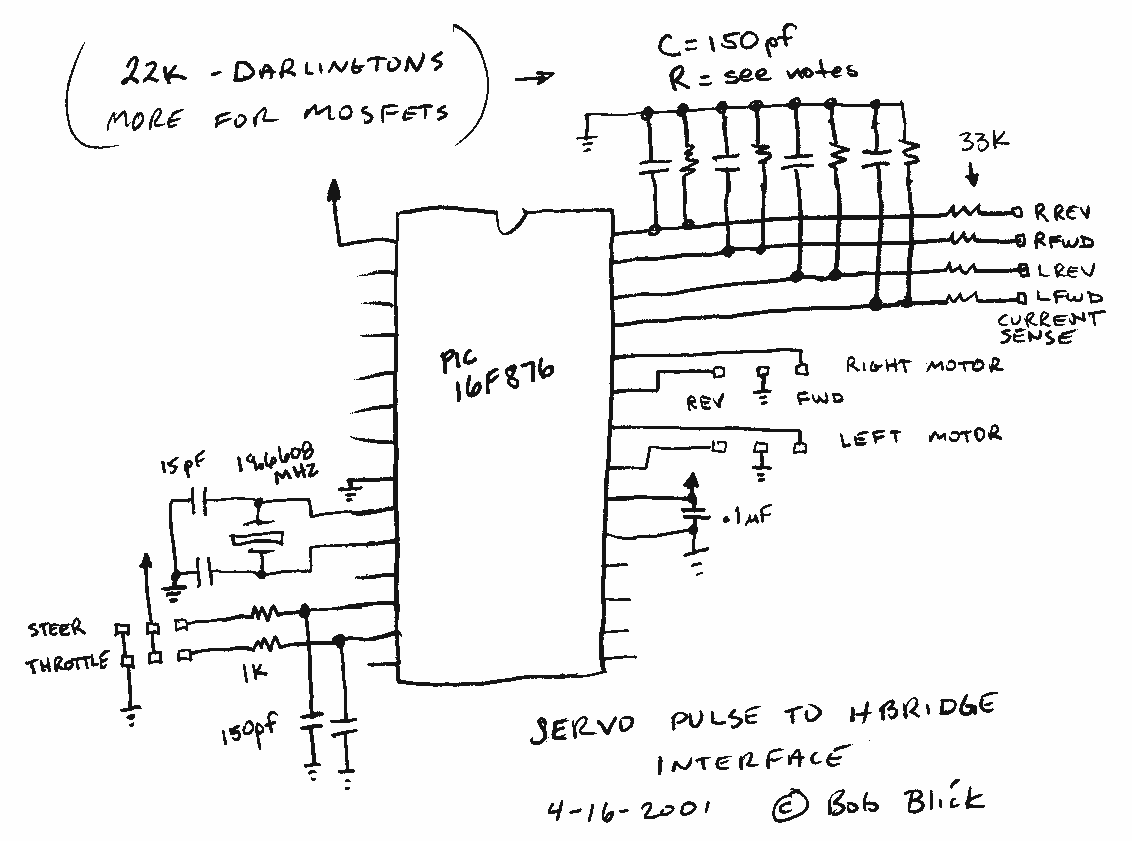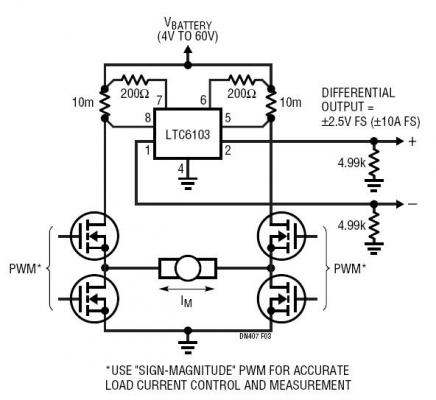
H-Bridge
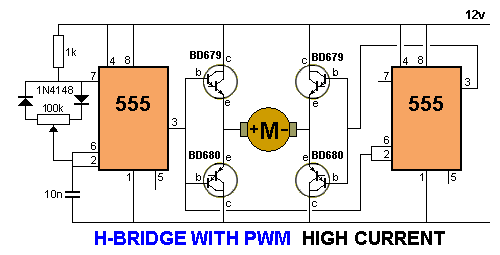
For a project such as a robot or car, an electronic circuit is required, controlled by a control circuit. This control circuit outputs signals to manage an H-Bridge. The circuit includes a Hex Bug design, where the control circuit is composed of the first three transistors. These transistors amplify the signal from an electret microphone, producing a signal capable of charging a 47µF electrolytic capacitor. The next two transistors provide inverted signals to the H-Bridge and are part of the control circuit. The H-Bridge consists of the last four transistors, which draw higher current when loaded, such as when a motor drives a load. The load can be anything from fingers placed on the output shaft to driving through a gearbox or turning wheels. The torque of the output shaft depends on voltage, current, the strength of the field magnet, and the quality of construction, particularly the proximity of the field magnet to the armature. The circuit must deliver a running current (up to 1 amp), a starting current (up to 5 amps), and a loaded current (up to 5 amps). Transistors must handle stalled current without damage. Various H-Bridge designs exist, and the circuit's specifics depend on the number of transistors, layout, control lines, and voltage. In this design, both inputs must never be HIGH simultaneously to avoid short-circuiting and damaging the transistors. The H-Bridge voltage can be any value, while the control voltage needs to exceed 1V. The circuit features an OFF state when both inputs are LOW but lacks a BRAKE feature. An alternative design using six transistors achieves the same functionality but does not offer advantages and uses additional components. The input voltage must exceed 1.5V, with A and B needing to be above 4V to deactivate line B. When line B is below 3.5V, it activates the circuit. Input timing prevents shoot-through current. The supply voltage for the 74C14 must match the H-Bridge voltage (5V to 18V). This circuit provides a BRAKE feature when both gate outputs are identical (either HIGH or LOW). A shoot-through current occurs during inverter state changes: when the gate output is low, the bottom transistor is off, and the top transistor is fully on. As the inverter output rises, both transistors turn on simultaneously. When the inverter is HIGH, the top transistor turns off. This design avoids shoot-through current during inverter state changes, albeit with different performance characteristics compared to the previous circuit. The voltage on the IC and H-Bridge must align. The transistors act as emitter followers, leading to a motor voltage lower than that in the previous circuit due to the output voltage of the IC, minus the drops across the 1k resistor and the base-emitter junction (approximately 1V). The total voltage drop to the motor due to both bridge sides is around 2V. This circuit is suitable for low-current motors, as the 74C14 can only supply 10mA, and the 1k base resistors limit current through the transistors. Resistors can be reduced to 470Ω. This circuit requires four inputs, with HIGH inputs around 12V and LOW inputs as close to 0V as possible. Proper input timing ensures no shoot-through current occurs.
The electronic circuit described serves as a control mechanism for robotic or automotive applications, specifically to manage motor functions through an H-Bridge configuration. The initial stage of the control circuit utilizes three transistors that amplify signals from an electret microphone, which is pivotal for sound detection or command execution in robotics. The amplification leads to a sufficient voltage level to charge a 47µF electrolytic capacitor, ensuring stable operation.
Following this, the circuit employs two additional transistors to generate inverted signals for the H-Bridge, allowing for bidirectional control of the motor. The H-Bridge itself, composed of four transistors, is crucial for managing the current flow to the motor, especially under load conditions. The design acknowledges the significance of torque, which is influenced by the voltage and current supplied, as well as the magnetic field strength and mechanical construction of the motor assembly.
The circuit's design ensures that it can handle various operational currents, with specific thresholds for running, starting, and loaded conditions. The transistors are selected for their ability to withstand stalled current, thus preventing damage during motor stall conditions. The requirement for careful input management is emphasized, particularly the need to avoid simultaneous HIGH signals on both inputs to prevent short-circuiting.
The circuit also features a BRAKE function, enhancing motor control by allowing for immediate cessation of motion when both outputs are equal. This is particularly useful in applications requiring quick stops. The mention of the 74C14 integrated circuit highlights the importance of matching supply voltages for optimal performance, as any discrepancy could lead to malfunction.
The design's adaptability is noted, allowing for variations in input and control voltages while maintaining functional integrity. The circuit's limitations, particularly in terms of current handling, are acknowledged, emphasizing the necessity for careful component selection to ensure reliable operation. Overall, this electronic circuit embodies a sophisticated approach to motor control in robotic applications, balancing complexity with functionality.For a project such as a robot or car, we need an ELECTRONIC circuit - one that is controlled by a "CONTROL CIRCUIT". The Control Circuit outputs a signal (or a number of signals) to control an H-Bridge. Here is a circuit of a Hex Bug. The Control Circuit consists of the first 3 transistors. These amplify the signal from the electret microphone and produce a signal that is able to charge a 47u electrolytic. The next two transistors provide inverted signals to the H-Bridge and are part of the Control Circuit. The H-Bridge consists of the last 4 transistors. 4. They all take a higher current when loaded - (the motor is driving a load). A load may be placing your fingers on the output shaft or driving through a gearbox and lifting a load or driving wheels via a gearbox.
The torque (twisting ability of the output shaft) depends on the voltage and current as well as the strength of the field magnet and the quality of construction (the closeness of the field magnet to the armature). It must also be able to deliver a "running current" (operating current) (say up to 1 amp) and a "starting current" (up to 5 amps), and a "loaded current" (up to 5 amps).
The transistors must be capable of passing a "stalled current" without being destroyed. There are a number of different H-Bridge designs and the actual circuit will depend on the number of transistors, the type of layout, the number of control lines, the voltage of the bridge, and a number of other factors. This design uses 4 transistors. Both inputs must NEVER be HIGH (this will create a short-circuit and damage the transistors). However this circuit is a good design. The voltage on the H-Bridge can be any voltage and the control voltage just needs to be higher than 1v.
The circuit provides OFF feature when both inputs are LOW but does not provide BRAKE feature. This design uses 6 transistors to do the same job as the circuit above. It does not have any advantages over the circuit above and simply uses extra components. The input voltage must be more than 1. 5v for A and B must be higher than 4v to turn off line B. When line B is less than 3. 5v, it activates the circuit. The timing of the inputs will prevent any "shoot through" current. This design requires the supply voltage to the 74C14 to be the same as the voltage on the H-Bridge (5v to 18v). The circuit provides BRAKE feature when the output of both gates are the same (either HIGH or LOW). There is a "shoot through" current during the time when the inverters change state and this occurs as follows: When the output of the gate is low, the bottom transistor is not turned on but the top transistor is fully turned ON.
When the output of the inverter rises, the top transistor is ON and the lower transistor is also turned on. When the inverter is HIGH, the top transistor is turned OFF. During the time when the inverter is changing from LOW to HIGH, both transistors are turned ON. This circuit does not have the "shoot through" current during the time when the inverters change state but it does not have the same performance as the circuit above.
The voltage on the IC and H-Bridge must be the same. The transistors are EMITTER FOLLOWERS and the voltage on the motor will be less than the voltages on the circuit above because the HIGH on the motor will be determined by the output voltage of the IC, minus the slight drop across the 1k and the voltage drop across the base-emitter junction of the transistor (a total of about 1v). The total voltage drop to the motor (due to both sides of the bridge) will be about 2v. The circuit is only suitable for a low-current motor as the 74C14 can only supply 10mA and the 1k base resistors will limit the current available through the transistors.
The resistors can be reduced to 470R. This circuit requires 4 inputs and the HIGH inputs must be about 12v. The LOW inputs need to be as close to 0v as possible. With correct timing of the inputs, no "sh 🔗 External reference
The electronic circuit described serves as a control mechanism for robotic or automotive applications, specifically to manage motor functions through an H-Bridge configuration. The initial stage of the control circuit utilizes three transistors that amplify signals from an electret microphone, which is pivotal for sound detection or command execution in robotics. The amplification leads to a sufficient voltage level to charge a 47µF electrolytic capacitor, ensuring stable operation.
Following this, the circuit employs two additional transistors to generate inverted signals for the H-Bridge, allowing for bidirectional control of the motor. The H-Bridge itself, composed of four transistors, is crucial for managing the current flow to the motor, especially under load conditions. The design acknowledges the significance of torque, which is influenced by the voltage and current supplied, as well as the magnetic field strength and mechanical construction of the motor assembly.
The circuit's design ensures that it can handle various operational currents, with specific thresholds for running, starting, and loaded conditions. The transistors are selected for their ability to withstand stalled current, thus preventing damage during motor stall conditions. The requirement for careful input management is emphasized, particularly the need to avoid simultaneous HIGH signals on both inputs to prevent short-circuiting.
The circuit also features a BRAKE function, enhancing motor control by allowing for immediate cessation of motion when both outputs are equal. This is particularly useful in applications requiring quick stops. The mention of the 74C14 integrated circuit highlights the importance of matching supply voltages for optimal performance, as any discrepancy could lead to malfunction.
The design's adaptability is noted, allowing for variations in input and control voltages while maintaining functional integrity. The circuit's limitations, particularly in terms of current handling, are acknowledged, emphasizing the necessity for careful component selection to ensure reliable operation. Overall, this electronic circuit embodies a sophisticated approach to motor control in robotic applications, balancing complexity with functionality.For a project such as a robot or car, we need an ELECTRONIC circuit - one that is controlled by a "CONTROL CIRCUIT". The Control Circuit outputs a signal (or a number of signals) to control an H-Bridge. Here is a circuit of a Hex Bug. The Control Circuit consists of the first 3 transistors. These amplify the signal from the electret microphone and produce a signal that is able to charge a 47u electrolytic. The next two transistors provide inverted signals to the H-Bridge and are part of the Control Circuit. The H-Bridge consists of the last 4 transistors. 4. They all take a higher current when loaded - (the motor is driving a load). A load may be placing your fingers on the output shaft or driving through a gearbox and lifting a load or driving wheels via a gearbox.
The torque (twisting ability of the output shaft) depends on the voltage and current as well as the strength of the field magnet and the quality of construction (the closeness of the field magnet to the armature). It must also be able to deliver a "running current" (operating current) (say up to 1 amp) and a "starting current" (up to 5 amps), and a "loaded current" (up to 5 amps).
The transistors must be capable of passing a "stalled current" without being destroyed. There are a number of different H-Bridge designs and the actual circuit will depend on the number of transistors, the type of layout, the number of control lines, the voltage of the bridge, and a number of other factors. This design uses 4 transistors. Both inputs must NEVER be HIGH (this will create a short-circuit and damage the transistors). However this circuit is a good design. The voltage on the H-Bridge can be any voltage and the control voltage just needs to be higher than 1v.
The circuit provides OFF feature when both inputs are LOW but does not provide BRAKE feature. This design uses 6 transistors to do the same job as the circuit above. It does not have any advantages over the circuit above and simply uses extra components. The input voltage must be more than 1. 5v for A and B must be higher than 4v to turn off line B. When line B is less than 3. 5v, it activates the circuit. The timing of the inputs will prevent any "shoot through" current. This design requires the supply voltage to the 74C14 to be the same as the voltage on the H-Bridge (5v to 18v). The circuit provides BRAKE feature when the output of both gates are the same (either HIGH or LOW). There is a "shoot through" current during the time when the inverters change state and this occurs as follows: When the output of the gate is low, the bottom transistor is not turned on but the top transistor is fully turned ON.
When the output of the inverter rises, the top transistor is ON and the lower transistor is also turned on. When the inverter is HIGH, the top transistor is turned OFF. During the time when the inverter is changing from LOW to HIGH, both transistors are turned ON. This circuit does not have the "shoot through" current during the time when the inverters change state but it does not have the same performance as the circuit above.
The voltage on the IC and H-Bridge must be the same. The transistors are EMITTER FOLLOWERS and the voltage on the motor will be less than the voltages on the circuit above because the HIGH on the motor will be determined by the output voltage of the IC, minus the slight drop across the 1k and the voltage drop across the base-emitter junction of the transistor (a total of about 1v). The total voltage drop to the motor (due to both sides of the bridge) will be about 2v. The circuit is only suitable for a low-current motor as the 74C14 can only supply 10mA and the 1k base resistors will limit the current available through the transistors.
The resistors can be reduced to 470R. This circuit requires 4 inputs and the HIGH inputs must be about 12v. The LOW inputs need to be as close to 0v as possible. With correct timing of the inputs, no "sh 🔗 External reference
